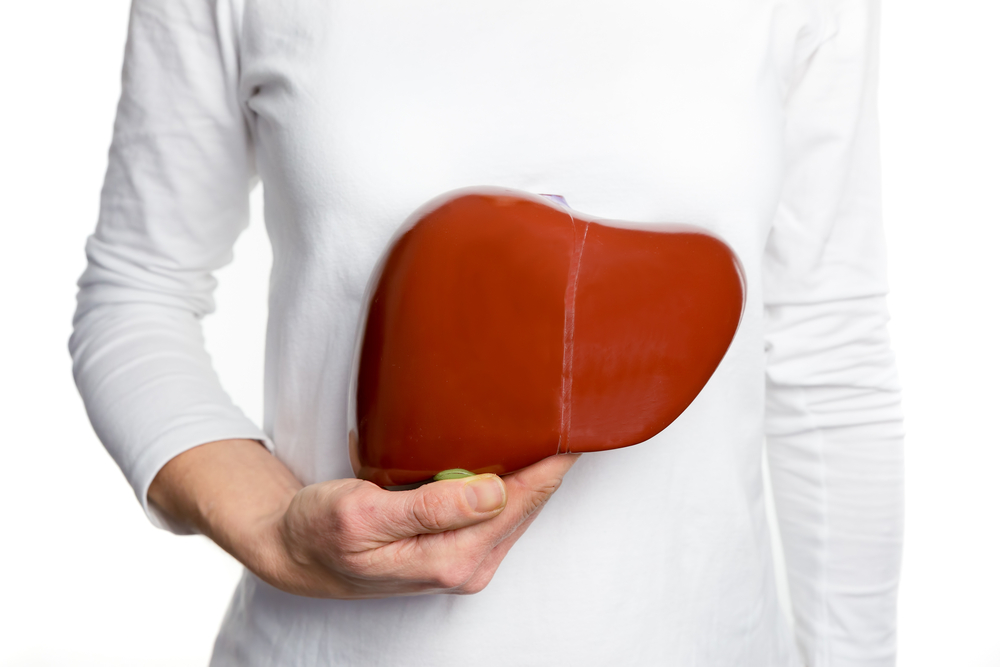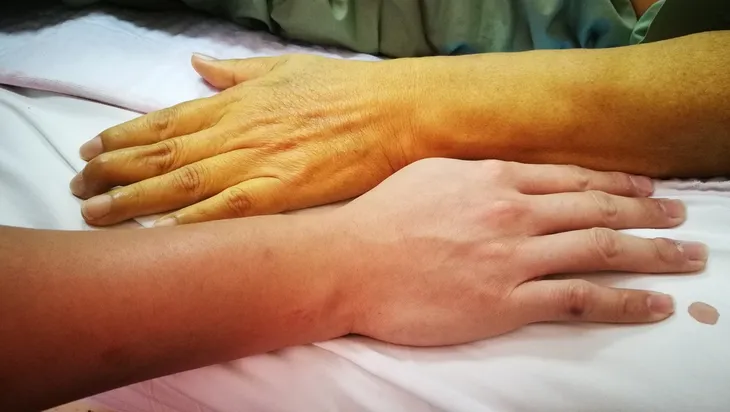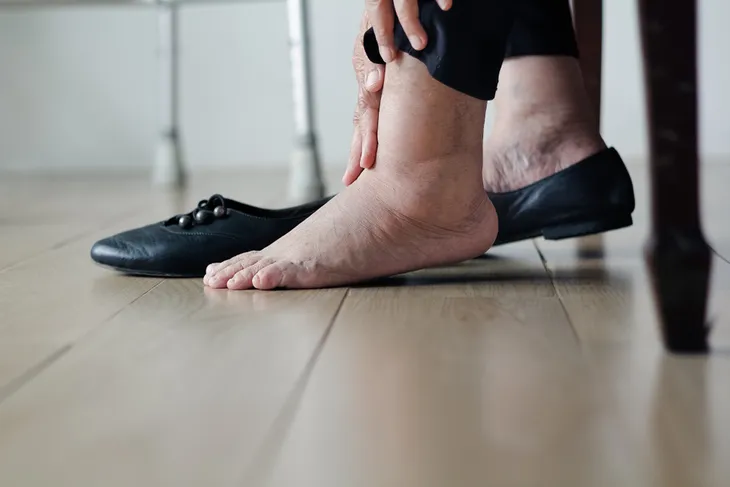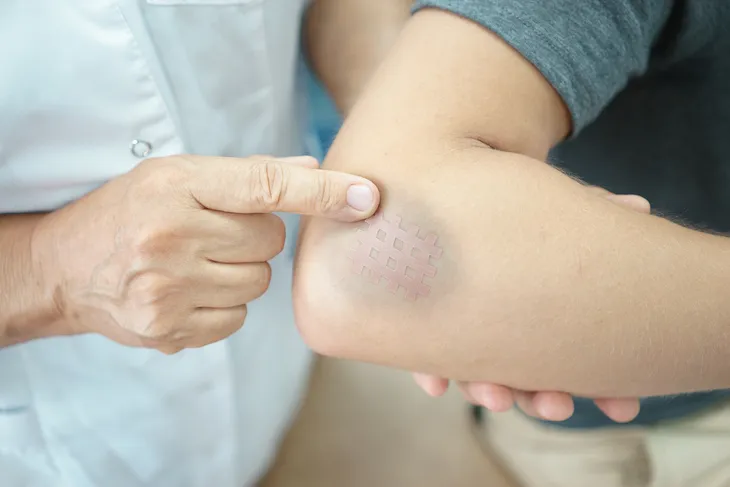The liver helps the body digest food, absorb nutrients, and eliminate toxic substances — we wouldn’t be able to live without this very important abdominal organ. This is why it’s so important to stay in tune with its wellness.
Leaving liver damage untreated can lead to scarring (cirrhosis), which could then lead to a life-threatening condition known as liver failure — even more reason to take care of it. Early intervention is also key but you’ll first have to know the 15 telling signs of a damaged liver. They are…
1. Swollen Abdomen
Cirrhosis, the serious progression of liver disease, causes fluid build-up in the abdomen (a condition referred to as ascites), as levels of albumin and proteins in the blood and fluid are retained. This may actually make the patient appear pregnant. While ascites can be caused by numerous medical conditions, cirrhosis of the liver is the single most common cause. Sometimes, swelling can also take place in the ankles, as accumulated fluid is drawn down into the body by the forces of gravity.
While ascites can occur in sudden onset or acute liver disease, it occurs much more frequently in chronic cases. It can be treated with diuretics and a reduced sodium diet, and in severe cases, the fluid can be drained through a needle inserted into the stomach. However, ascites may not respond to frontline treatments, and if not, more drastic measures, such the insertion of a shunt or a liver transplant, may be necessary.
2. Jaundice
Discolored skin and eyes that take on a yellowish hue is symptomatic of liver damage. This yellowing of the skin and whites of the eyes results as bilirubin (a bile pigment) builds up in the blood and is unable to be eliminated as waste from the body. Jaundice also causes dark-colored urine and light-colored stools, and the high bilirubin levels can also trigger difficult-to-relieve full-body itching. In extremely severe cases, jaundice can also cause a loss of brain function. In older patients, this is often misdiagnosed as a dementia-related disorder.
Treating liver disease-related jaundice depends on successfully addressing the underlying medical condition. While severely damaged livers will never fully regenerate, jaundice and its related symptoms will diminish in intensity as liver function improves. However, it’s important to remember that liver disease isn’t cured when jaundice disappears; patients who recover from severe liver damage must still be very careful to maintain better health.
3. Abdominal Tenderness
Abdominal pain, particularly in the upper right corner of the abdomen or to the lower right portion of the rib cage is a telling sign of liver damage. This pain may or may not be accompanied by swelling in the abdomen, or ascites. Patients usually characterize it as a persistent throbbing or stabbing pain that can only be temporarily relieved by medications. In fact, improper use of medications can be part of the reason you’re experiencing abdominal pain symptoms.
It’s important to remember that liver disease can be caused by long-term overuse of certain over-the-counter and prescription medications, including acetaminophen and narcotic-acetaminophen combinations. These medications may cause upset stomach as a general side effect, and their damaging attributes can be amplified if you drink alcohol while using them. The upset stomach side effects can snowball over the long term as liver damage appears. Eventually, this pain will become severe enough for patients to seek medical attention.
4. Urine Changes
Urine may become dark yellow in color due to increased levels of bilirubin in the body’s bloodstream, which the damaged liver is unable to eliminate via excretion through the kidneys. Bilirubin is a bodily fluid that is produced through the natural breakdown of bile, and is normally eliminated through bile and urine. It is believed to function as a cellular-level antioxidant, but excessive amounts can lead to toxicity. Uncontrolled reflexes and eye movements, seizures, and neurological impairments can all result from chronically high bilirubin levels.
Dark urine can be caused by many different factors, and it isn’t something to be alarmed about if it does not occur on a continuous basis. Dehydration, gallstones, infections of the bile duct, and enzyme deficiencies can all cause changes in the color and composition of urine. If your urine is persistently dark yellow or brown in color, or if it is unusually malodorous and pungent, you should visit your doctor for a diagnosis.
5. Irritated Skin
Itchy skin that doesn’t seem to go away and develops into a flaky rash is another telltale sign of serious liver damage. Skin irritation results from the body’s lack of fluid flow, which most commonly manifests on the surface of the skin in thick, flaky, itchy patches. Liver disease can also cause other skin problems, including a generalized yellowing of the skin and mucus membranes (jaundice), reddening of the feet or hands, and changes in skin tone and color. These changes can result in unusually dark or unusually light patches of skin in localized areas.
In some cases, patients experience the appearance of veins through the skin. If any of these symptoms appear, particularly if they are accompanied by itching, you should speak to your doctor. He or she can check for signs of liver problems by performing a few simple, painless tests.
6. Stool Changes
Liver damage frequently causes a number of changes in bowel movements. Typically, these symptoms present in one of three ways: you may experience constipation, symptoms of irritable bowel syndrome (IBS), or changes in the color and makeup of your stool. Any or all of these symptoms may appear in patients suffering from undetected and untreated cases of liver disease or cirrhosis.
Constipation is the impaction of bowel movements, which harden in the lower abdomen and become very difficult to pass. While constipation is something that happens from time to time, if it becomes chronic, it could signal a problem. Symptoms of IBS include alternating bouts of constipation and diarrhea, abdominal pain, and a frequent, sudden, and urgent need to pass bowel movements. Finally, people with liver disease may experience changes in stool, including an unusually pale color; a thick, tar-like consistency; or the presence of blood in bowel movements.
7. Nausea
Digestive issues, including indigestion and acid reflux, can rear their ugly heads with liver damage and even lead to vomiting attacks. In fact, unexplained and persistent vomiting is considered to be one of the definitive clues that a patient may be suffering from liver problems. When vomiting occurs without the presence of any stomach or intestinal tract issues, it is considered a serious medical problem and should be investigated thoroughly.
In patients with liver damage, persistent feelings of nausea arise from the body’s diminished ability to process and eliminate toxins as well as changes in metabolism and digestion. Many people mistake the root cause of the nausea or ignore it altogether, as it is usually not considered to be a serious medical problem. A good rule of thumb to follow is this: if you notice any persistent changes in your health, no matter how minor they may seem, see your doctor to find out what the problem is.
8. Loss of Appetite
When liver damage is left untreated, it will progress into liver disease. If it remains undiagnosed and unmanaged for an extended period of time, increasingly serious symptoms will result. Significant changes in appetite that result in dramatic, rapid weight loss is one such symptom. This is considered to be a sign of fairly advanced liver disease, which is life-threatening in and of itself, to say nothing of the many potential health problems that can be caused by malnutrition.
Patients who have degenerated to the point of rapid, severe weight loss may not feel well enough to eat, or they may become so ill that they cannot keep food down. In such cases, doctors will administer nutrients intravenously to slowly bring the patient back to health. However, liver damage which has reached this point typically has a more grim prognosis, as the organ will be beyond repair and a transplant may be the patient’s only hope for recovery.
9. Fluid Retention
Serious liver damage can also lead to fluid retention in the legs, ankles, and feet. This occurs because impaired liver function inhibits the body’s ability to produce and circulate proteins, which in turn causes circulatory issues that are localized in the legs, feet, and ankles because gravity naturally draws fluid down to the lower parts of the body. One of the characteristics of liver disease-related fluid retention is that the imprint of your fingers will remain for a few seconds if you press down on an affected area.
This fluid retention can also be caused or worsened by decreased kidney function, which often accompanies severe liver damage. In addition to the legs, feet, and ankles, fluid retention may also occur in the abdomen. In non-severe cases, these issues can be treated with diuretics that trigger urination and the elimination of excess bodily fluids. More aggressive treatments, such as surgical fluid drainage, may be necessary if diuretics fail.
10. Exhaustion
Chronic fatigue, muscle and mental weakness, memory loss, even confusion, and eventually coma are common when a damaged liver progresses to liver failure. Researchers have noted that exhaustion and fatigue are the single most common symptoms of liver damage, and it typically has a significant and damaging impact on the patient’s quality of life. Unfortunately, the specific causes of liver disease-related fatigue and exhaustion are not fully understood.
Researchers speculate that the root cause of liver disease-related chronic fatigue may be caused by changes in brain chemistry and hormone levels that result from impaired liver function. In particular, altered levels of corticotropins, serotonin, and noradrenaline may be at the root of depleted energy levels. Researchers also note that fatigue-related symptoms are likely worsened by a general increase in the presence of toxic byproducts in the blood, which the damaged liver cannot properly eliminate.
11. Bruising Easily
When the liver becomes damaged, it slows or entirely stops producing the proteins that are necessary for blood clotting by the platelets. As a result, affected individuals will notice that they tend to bruise or bleed more easily—a common visual sign that your liver is struggling.
Proneness to bruising may also be caused by a blood disorder, which people with liver damage or liver disease are more likely to develop. So if you notice more areas of skin discoloration appearing on your body and can’t explain how they got there, be sure to visit your doctor.
12. Liver Encephalopathy
As mentioned earlier, confusion and memory loss may also occur when there is damage to the liver. These symptoms are actually a condition called liver encephalopathy, which occurs because the liver is unable to “filter blood normally and remove harmful substances from the bloodstream,” says Livestrong.com.
As a result, “toxins can build up and travel to the brain,” leading to the abovementioned confusion and memory loss, as well as “mood changes, impaired judgment, disorientation, sluggish speech and movement, drowsiness and coma.” If you experience any of these symptoms, be sure to seek immediate medical attention, as the condition can be fatal.
13. Excessive Sweating
Damage to the liver—whether because of toxins, disease, or a hereditary condition—means that this crucial organ has to work harder than normal to perform its regular functions. When it does this, it generates a lot of heat, and due to the liver’s size, this heat radiates out, causing the temperature of the whole body to increase.
As a result, excessive sweating tends to occur, which is the body’s way of trying to cool itself down. It is also trying to excrete as many toxins as it can through the skin, which is a duty the liver would normally perform, but is unable to do effectively due to the damage.
14. Weight Gain and High Cholesterol
As the liver is largely responsible for burning fat and regulating metabolism, when it becomes damaged, unwanted weight gain can often occur. You’ll tend to notice this weight gain in the abdominal area, which is often referred to as a “pot belly,” or you may develop a roll of fat at the upper abdomen, which can be a sign of fatty liver.
Additionally, liver damage may also cause you to develop high cholesterol, because the organ will not produce enough “good” cholesterol, which “travels out of the liver to scavenge the unhealthy cholesterol (LDL) from the blood vessel walls,” according to LiverDoctor.com. As a result, there is an increased risk of developing high blood pressure, heart attacks, and strokes.
15. No Symptoms
In approximately 50 percent of cases, there are no physical signs and symptoms that the liver is damaged. This may be because it is too early for onset to occur or simply because the individuals are asymptomatic, and should they experience mild symptoms, they tend to be non-specific (e.g., tiredness, lack of drive, and itching). Therefore, people often dismiss them as being caused by something else.
Unfortunately, this means they will not be prompted to seek treatment, which can lead to more serious conditions, including fibrosis, cirrhosis, liver cancer, and liver failure.


















